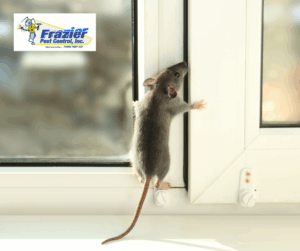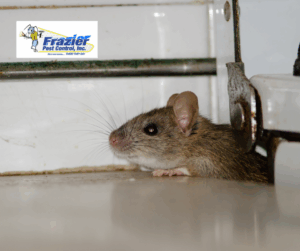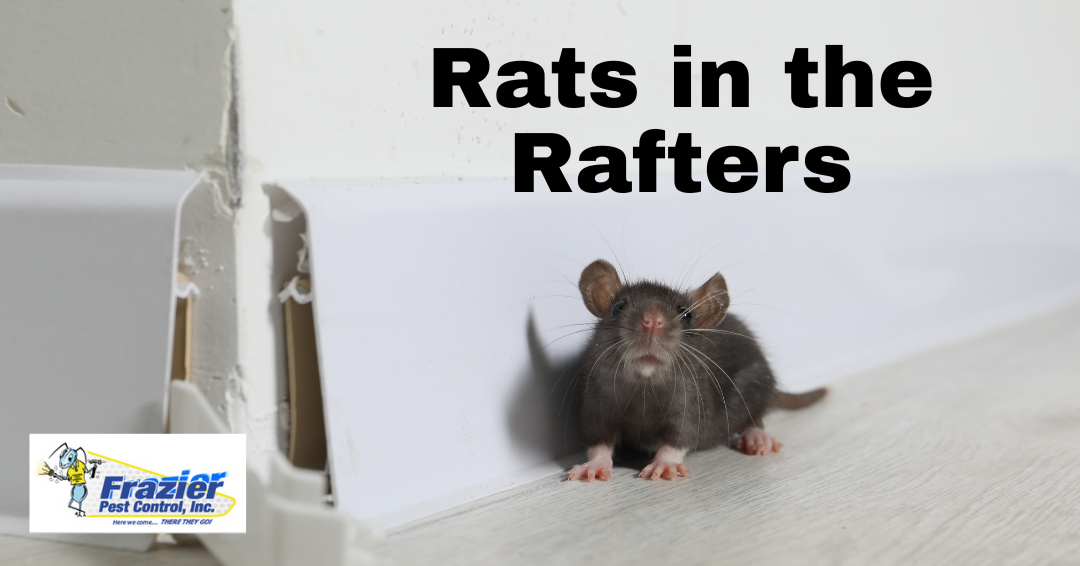As desert nights grow cooler, rats and mice begin searching for warmth — and too often, they find it in your attic.
In the Coachella Valley, fall is prime time for rodent infestations. Unlike cold-climate rodents that burrow underground, desert rats and mice prefer elevated shelter — rafters, attics, and crawl spaces that stay dry and warm year-round. Once they’re inside, they can chew wires, destroy insulation, and contaminate your home with droppings and urine.
At Frazier Pest Control, we’ve seen the damage these desert invaders can cause — and we know how to stop them before they make themselves at home.
Read more: Mice in Coachella Valley Homes: Signs, Risks, and Removal
Why Rodents Move Indoors in the Fall
 Even though fall in the Coachella Valley is mild, the temperature difference between night and day is enough to trigger rodent migration. Here’s why:
Even though fall in the Coachella Valley is mild, the temperature difference between night and day is enough to trigger rodent migration. Here’s why:
- Temperature changes: Rats and mice seek stable warmth at night when outdoor temperatures dip.
- Food scarcity: With fewer insects and plants available in the cooler months, rodents turn to pantries, pet food, and garbage for easy meals.
- Breeding behavior: Rats can breed year-round in warm climates, but they move indoors in fall to protect nests and offspring from predators and fluctuating temperatures.
- Structural access: Small cracks, roof vents, and gaps in eaves or attic screens are ideal entry points — especially in older or seasonally vacant homes.
Read more: Why Subterranean Termites Often Go Undetected in Coachella Valley Homes
Signs of Rats or Mice in the Rafters
 Rats are stealthy, but they leave plenty of clues. Watch for these signs around your home:
Rats are stealthy, but they leave plenty of clues. Watch for these signs around your home:
- Scratching or scurrying sounds in the ceiling or walls, especially at night.
- Droppings the size of rice grains in attics, pantries, or under sinks.
- Chewed wires, insulation, or cardboard boxes.
- Foul or musty odors caused by urine, nesting materials, or dead rodents.
- Grease marks or rub trails along baseboards and rafters where rodents travel.
If you notice one or more of these warning signs, you likely have more than a single rodent — and the sooner you act, the easier it is to eliminate them.
Read more: Argentine Ants in the Coachella Valley: The Unstoppable Invasion
Why You Shouldn’t Ignore Rodents in the Attic
Rodents aren’t just messy — they’re destructive and dangerous.
Here’s what makes them a serious problem:
- Fire hazard: Rodents constantly chew to keep their teeth short, and electrical wiring is a favorite target. Frayed wires can spark and cause fires.
- Health risks: Rats and mice carry bacteria and viruses such as Salmonella and Hantavirus, which can contaminate surfaces and air.
- Insulation damage: Nesting rodents tear insulation apart, reducing energy efficiency and driving up utility bills.
- Structural damage: Over time, their droppings and urine can soak into wood beams and drywall, causing long-term odor and staining.
Read more: Pest Control in Coachella Valley: Why Professional Services Matter for Your Property’s Safety
How to Keep Rats Out of the Rafters
Prevention is always better — and cheaper — than repair. Here’s how to protect your home before rodents move in:
- Seal entry points: Inspect your roofline, attic vents, and eaves for openings as small as a quarter-inch. Use steel wool, wire mesh, or foam sealant to block gaps.
- Trim vegetation: Keep palm fronds, tree branches, and vines from touching your roof — rodents use them as bridges.
- Eliminate food sources: Store pet food, birdseed, and pantry goods in sealed containers. Keep garbage lids tight.
- Reduce clutter: Clear storage areas where rodents can hide or nest, especially in garages or attics.
- Schedule a professional inspection: Local technicians can identify droppings, chew marks, and access points that the average homeowner might miss.
Read more: Why Squishing Ants Can Make Your Infestation Worse
Why Rodents Love Desert Homes
In desert regions like the Coachella Valley, homes offer ideal nesting conditions — warmth, shade, and water from air conditioning condensation or leaky pipes.
Vacation homes and snowbird properties are especially vulnerable because they sit quiet for months at a time, giving rodents uninterrupted shelter.
Even newer homes can be at risk if attic vents, tile roofs, or crawl spaces aren’t properly screened.
Read more: Scorpions in the Desert: Vigilant Strategies for Coachella Valley Homes
Protecting Your Home Starts Now
Once rodents settle into your rafters, they multiply fast — and one family can turn into dozens in just a few weeks.
At Frazier Pest Control, we specialize in rodent inspections, exclusion, and prevention. Our technicians know the habits of desert rats and mice and use safe, targeted methods to keep them out for good.
Don’t wait until you hear scratching above your ceiling at midnight. Call Frazier Pest Control today to schedule your fall rodent inspection and protect your home from costly damage. (760) 328-6115
Read more: Can Cockroaches Really Live Without Their Heads?
FAQ: Rodents in the Rafters
Q: How do rats get into the attic if my home seems sealed?
A: Rats only need a gap the size of a quarter to squeeze through. They often enter through roof vents, attic screens, loose tiles, or openings around utility lines.
Q: What kind of rats live in the Coachella Valley?
A: The most common species are roof rats and Norway rats. Roof rats are excellent climbers and prefer attics and palm trees, while Norway rats burrow underground.
Q: Is it safe to handle rodent droppings myself?
A: No. Rodent droppings can contain harmful bacteria and viruses. Always wear gloves and a mask — or better yet, let professionals handle the cleanup.
Q: Will rats leave on their own when the weather warms up again?
A: No. Once rats establish a nesting site indoors, they rarely leave. The warmth, food, and protection are too convenient.
Q: How quickly can an infestation grow?
A: A single pair of rats can produce up to a dozen offspring every two months. That means a small problem can turn into a major infestation by winter.


Recent Comments